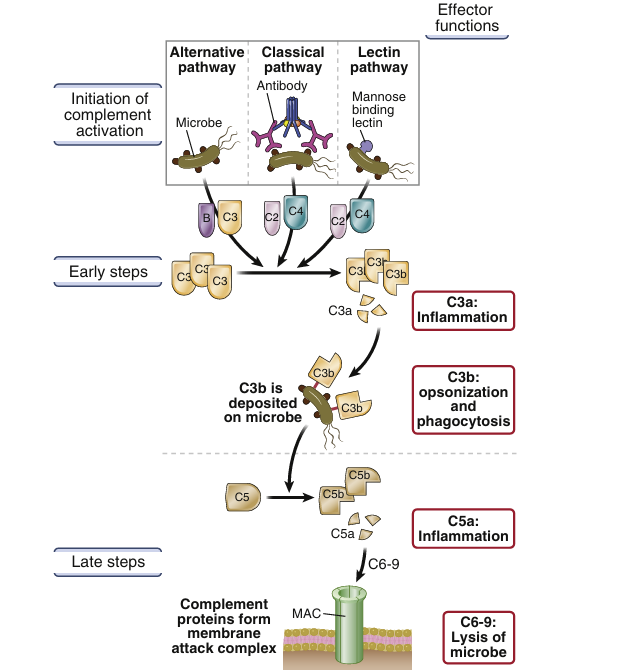
Complement system
 المؤلف:
Abbas, A. K., Lichtman, A. H., & Pillai, S
المؤلف:
Abbas, A. K., Lichtman, A. H., & Pillai, S
 المصدر:
Basic Immunology : Function and disorders of immune system
المصدر:
Basic Immunology : Function and disorders of immune system
 الجزء والصفحة:
6th ed , page 39-40
الجزء والصفحة:
6th ed , page 39-40
 2025-01-16
2025-01-16
 945
945
The complement system is a collection of circulating and membrane-associated proteins that are important in defense against microbes. Many complement proteins are proteolytic enzymes, and complement activation involves the sequential activation of these enzymes. The complement cascade may be initiated by any of three pathways (Fig. 1):
• The alternative pathway is triggered when some complement proteins are activated on microbial surfaces and cannot be controlled, because complement regulatory proteins are not present on microbes (but are present on host cells). The alternative pathway is a component of innate immunity.
• The classical pathway is most often triggered by antibodies that bind to microbes or other antigens and is thus a component of the humoral arm of adaptive immunity.
• The lectin pathway is activated when a carbohydrate-binding plasma protein, mannose-binding lectin (MBL), binds to its carbohydrate ligands on microbes. This lectin activates proteins of the classical pathway, but because it is initiated by a microbial product in the absence of antibody, it is a component of innate immunity.
Activated complement proteins function as proteolytic enzymes to cleave other complement proteins. Such an enzymatic cascade can be rapidly amplified because each proteolytic step generates many products that are themselves enzymes in the cascade. The central component of all three complement pathways is a plasma protein called C3, which is cleaved by enzymes generated in the early steps. The major proteolytic fragment of C3, called C3b, becomes covalently attached to microbes and is able to recruit and activate downstream complement proteins on the microbial surface. The three path ways of complement activation differ in how they are initiated, but they share the late steps and perform the same effector functions. T he complement system serves three main functions in host defense:
• Opsonization and phagocytosis. C3b coats microbes and promotes the binding of these microbes to phagocytes by virtue of receptors for C3b that are expressed on the phagocytes. Thus, microbes that are coated with complement proteins are rapidly ingested and destroyed by phagocytes. This process of coating a microbe with molecules that are recognized by receptors on phagocytes is called opsonization.
• Inflammation. Some proteolytic fragments of complement proteins, especially C5a and C3a, are chemoattractants for leukocytes (mainly neutrophils and monocytes), and they also are activators of endothelial cells and mast cells. Thus, they promote movement of leukocytes and plasma proteins into tissues (inflammation) at the site of complement activation.
• Cell lysis. Complement activation culminates in the formation of a polymeric protein complex that inserts into the microbial cell membrane, disturbing the permeability barrier and causing osmotic lysis.

Fig. 1 Pathways of complement activation. The activation of the complement system (the early steps) may be initiated by three distinct pathways, all of which lead to the production of C3b. C3b initiates the late steps of complement activation, culminating in the formation of a multiprotein complex called the membrane attack complex (MAC), which is a transmembrane channel composed of polymerized C9 molecules that causes lysis of thin-walled microbes. Peptide by-products released during complement activation are the inflammation-inducing C3a and C5a.
 الاكثر قراءة في المناعة
الاكثر قراءة في المناعة
 اخر الاخبار
اخر الاخبار
اخبار العتبة العباسية المقدسة


